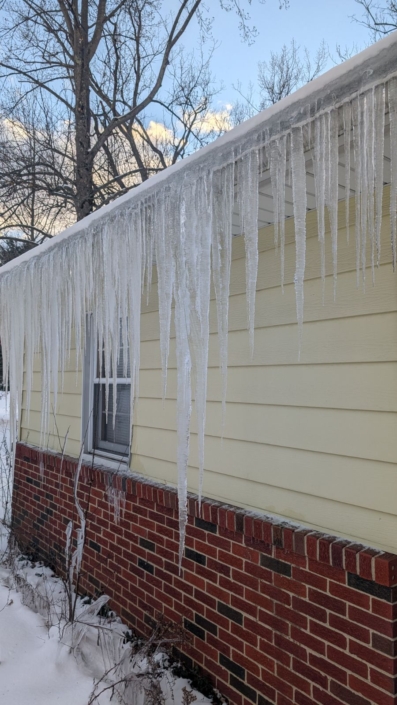
Snow-covered trees, frosted windows, and sparkling icicles—winter in Northeast Ohio can feel like a scene from a holiday postcard. But while icicles hanging from your roof may look charming, they could be warning you about serious problems with your home.
At Front Line Inspection Services, we help homeowners understand what’s cosmetic—and what’s potentially costly. Here’s what you should know about icicles, ice dams, and how to protect your home this winter.
Icicles form when heat escapes from your attic, melts the snow on your roof, and the runoff refreezes at the colder eaves (roof edges). This process often signals poor insulation or ventilation.
Key causes include:
The result? A winter drip that turns into dangling ice—and possibly damage below.
While small icicles may be harmless, larger ones often go hand-in-hand with ice dams, which can cause expensive water damage. Here’s why icicles may be a red flag:
Thick ice buildup along the roof edge prevents melting snow from draining properly. Water can back up under your shingles, causing leaks into your attic or walls.
Icicles are heavy—and that weight can bend, loosen, or break your gutters.
Falling icicles can injure people or pets and damage vehicles or property beneath them.
Preventing icicles starts with keeping your roof cold, not warm. These solutions help stop the melt-freeze cycle:
Proper insulation prevents heat from escaping into the attic. A colder roof = less melting = fewer icicles.
Close gaps around chimneys, recessed lights, plumbing vents, and attic hatches to stop warm air from leaking upward.
Balanced ventilation helps maintain an even temperature across your roof.
After heavy snow, gently rake off the snow near your roof’s edge (from the ground) to reduce meltwater buildup.
Heated cables along roof eaves can melt small channels in the snow to allow safe drainage, preventing ice dams from forming.
If you’re seeing signs of ice damage—or aren’t sure how to prevent it—it’s time to get expert help. Call a pro if:
At Front Line Inspection Services, we help homeowners spot these issues early through our detailed winter home inspections. We can evaluate your roof, attic ventilation, and overall insulation health—and recommend smart next steps to keep your home protected.
They might look magical, but icicles can be a sign your home isn’t winter-ready. With the right prevention strategies and routine inspections, you can keep your roof intact, your attic dry, and your heating bills in check.
❄️ Need a winter inspection or advice on preventing ice dams?
Contact Front Line Inspection Services today—we’re here to help you stay safe, warm, and worry-free all season long.
Serving Cleveland, Akron, Canton, Medina, Strongsville, and communities throughout Northeast Ohio, our experienced inspectors deliver clarity, honesty, and timely reports so you can confidently move forward with your real estate decisions.
